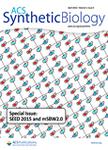版权所有:内蒙古大学图书馆 技术提供:维普资讯• 智图
内蒙古自治区呼和浩特市赛罕区大学西街235号 邮编: 010021

作者机构:Microsoft Res Cambridge CB1 2FB England Univ New Mexico Dept Comp Sci Albuquerque NM 87131 USA Univ New Mexico Ctr Biomed Engn Albuquerque NM 87131 USA
出 版 物:《ACS SYNTHETIC BIOLOGY》 (ACS合成生物学)
年 卷 期:2019年第8卷第7期
页 面:1530-1547页
核心收录:
学科分类:0710[理学-生物学] 071010[理学-生物化学与分子生物学] 081704[工学-应用化学] 07[理学] 08[工学] 0817[工学-化学工程与技术]
基 金:National Science Foundation [1518861, 1525553, 1814906] Direct For Computer & Info Scie & Enginr Division of Computing and Communication Foundations [1518861, 1525553] Funding Source: National Science Foundation Division of Computing and Communication Foundations Direct For Computer & Info Scie & Enginr Funding Source: National Science Foundation
主 题:strand graph site graph process calculus programming language DNA computing molecular programming biological computation logic programming
摘 要:Computational nucleic acid devices show great potential for enabling a broad range of biotechnology applications, including smart probes for molecular biology research, in vitro assembly of complex compounds, high-precision in vitro disease diagnosis and, ultimately, computational theranostics inside living cells. This diversity of applications is supported by a range of implementation strategies, including nucleic acid strand displacement, localization to substrates, and the use of enzymes with polymerase, nickase, and exonuclease functionality. However, existing computational design tools are unable to account for these strategies in a unified manner. This paper presents a logic programming language that allows a broad range of computational nucleic acid systems to be designed and analyzed. The language extends standard logic programming with a novel equational theory to express nucleic acid molecular motifs. It automatically identifies matching motifs present in the full system, in order to apply a specified transformation expressed as a logical rule. The language supports the definition of logic predicates, which provide constraints that need to be satisfied in order for a given rule to be applied. The language is sufficiently expressive to encode the semantics of nucleic strand displacement systems with complex topologies, together with computation performed by a broad range of enzymes, and is readily extensible to new implementation strategies. Our approach lays the foundation for a unifying framework for the design of computational nucleic acid devices.